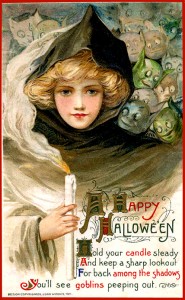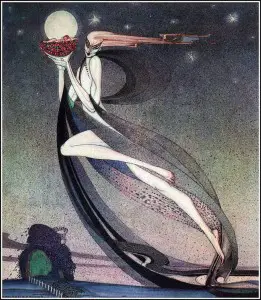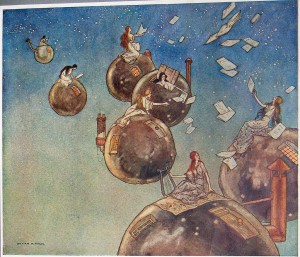I have no idea! And that’s why I am writing this article, because I’ve had a long discussion on another site about vintage illustration being copied, and one argument against copying public domain images from rare books or postcards is that it hurts the rare paper ephemera business and book sellers.
Does it? Do say, reprints of Arthur Rackham’s illustrated titles lower the interest of a serious buyer of a first edition? If an exact copy of a certain edition of an illustrated Huckleberry Finn remove the value of a first?
I’ve no data to back up my feeling on this subject, and I’d appreciate people weighing in, even if telling me my suppositions are completely off base. I am really seriously curious as to the general consensus of what flooding the market with reprints of valuable tomes and other paper ephemera does or doesn’t do to market values and demand.
I don’t believe it affects the rare book or postcard business, or if it does, it’s in a minimal way. One of my bosses has the rarest first editions of crime fiction, and decided to give the general population the experience that readers had when the books were first published. He reprinted, exactly, down to the weight of the paper, each famous title, from Hammett, to Chandler, To Woolrich. I bought two or three of the reprints, with the incredible art work on the facsimile dust jackets. They weren’t cheap, back in the 90s, thirty-five dollars was a little heftier than the usual hardcover. But it was a real pleasure picking up Rex Stout’s first Nero Wolfe novel, Fer-De-Lance, and reading it in this edition, rather than a used beat up paperback with bad graphics, or even a newly minted paperback edition right off the presses. The feel of heft in my hand, the stiffness of paper, the glimpse of artwork when turning to the next page, was a real experience, a sensation. Maybe it became more of an experience because it was toted that way, but even so, it was delightful knowing that although there wasn’t a snow balls chance in the lower quarters, that I’d ever be able to afford a first in jacket, that I had this wonderful facsimile to place on my shelves and feel a little bit of ownership of the real thing.
The key here–I could never afford a first in jacket–if I could find– one it would range in the many thousands. So, was the possible sale of a first Fer-De-Lance impacted by the facsimile–not where someone like me is concerned. But what of those few seriously well endowed book lovers? Would they decide after seeing this version, that, ‘nah, I don’t need no stinkin’ first edition, when I can have this one cheap.’ Uh, no. I cannot picture a rich book collector settling for such a nice, but totally inferior piece as compared to the treasure he could own.
So, was the possible sale of a first Fer-De-Lance impacted by the facsimile–not where someone like me is concerned. But what of those few seriously well endowed book lovers? Would they decide after seeing this version, that, ‘nah, I don’t need no stinkin’ first edition, when I can have this one cheap.’ Uh, no. I cannot picture a rich book collector settling for such a nice, but totally inferior piece as compared to the treasure he could own.
But what about something less extreme, say, a pile of fairy postcards, or Halloween ones, that collectors pay such tremendous sums for due to rarity. Would Dover’s or some other reproductions put a crimp in the profits of rare postcard dealers? I don’t know, for certain. I would collect Halloween postcards in a heartbeat, if I could afford the 50 to a couple hundred bucks for just one. I have a few of my own, creased ones, or bent, scuffed, all way cheaper than ones in fine condition. And remember, condition is everything. So basically, I could have a perfect reprint and it may look better than my crumpled original. Still, given my love of the real thing, I’d rather have crumpled if it is affordable. So, for me–if an original comes along I can afford, it will beat out a perfect repro every time. But when I can’t afford one, which with Halloween, it’s ninety per cent of the time, I am comforted in the knowledge that reprints are available to those who love Halloween ephemera, as much as those who can afford it.
 Again, would a serious postcard collector decide not to spend two hundred on say the rarest card of all, the beautiful girl with a candle and fairies all around her if it is available in a nicely done reprint? I just can’t imagine that scenario. It would make no sense. If one is a collector, then one collects–real first editions, antique postcards, illustrated first edition children’s books etc., etc.
Again, would a serious postcard collector decide not to spend two hundred on say the rarest card of all, the beautiful girl with a candle and fairies all around her if it is available in a nicely done reprint? I just can’t imagine that scenario. It would make no sense. If one is a collector, then one collects–real first editions, antique postcards, illustrated first edition children’s books etc., etc.
Then the morality of taking public domain images and reproducing them for those who can’t afford to collect, but wants the experience of seeing gorgeous art pieces, comes into play for some collectors. The collectors themselves may not enjoy knowing their treasures are being reproduced on a daily basis after paying a gazillion dollars to own them. I’ll admit, I was a bit peeved when after I had posted a few rare rare pictures of The Ship That Sailed to Mars on flickr, and felt like the Pied Piper for having been able to provide this scarce experience, lol, I found entire book had been reproduced after my uploads, somewhere online for all to see and download. I mean, I paid the 1100 bucks for this rarity, shouldn’t I alone be able to bask in its glory, and only deal out bits and pieces of it at my discretion.
I won’t deny that it felt pretty cool to own something that rare, that so few people ever had a chance to see. But, I want access to other rare pieces, Kay Nielsen’s In Powder and Crinoline is a book I will never be able to own–yet because several people who do own a copy have shared the remarkable plates online and in books, I am able to at least enjoy them virtually or in postcards, posters, etc. Is this wrong? Does that affect the market? And what about the idea of CD compilations–if an entire set of illustrations from the Neilsen classic are within a CD, will that really be the thing that nails a coffin on the rare or collectible book market? If every single rare Halloween postcard is within a DVD, does that mean the end to collecting any Halloween postcard–if you can push something into your computer and press print, and all these rare expensive images come out–isn’t that something that real collectors might prefer, to paying loads of cash for one or two postcards?
Again, I have to say, no. There is NOTHING like an original. No matter what reproduction processed used, how costly the paper, how fine the colors, the original within the book is superior, just as the actual work of art used for the book is superior to anything processed and printed. And those who would have bought the Neilsen, would still buy the Neilsen, and people who live and breathe vintage postcards will still buy them. The CDs and DVDs are for the rest of us, we who shouldn’t have to be deprived of art because we can’t afford it, and others can. With all this incredible technology, rare art is at a fingertip, and it disturbs some whose collection is used for such purposes-those who like to share their pieces, but not if others take them and reproduce them and make money. So where is the line crossed? If one had a collection of rare illustrated books, goes to the trouble and work to scan everyone to share online, should that person feel that they now ‘own’ the images? Can someone who has a big collection of rare postcards and compiles them into a book, or a CD, does that mean they now own the images within? Even if in the public domain?
DVDs are for the rest of us, we who shouldn’t have to be deprived of art because we can’t afford it, and others can. With all this incredible technology, rare art is at a fingertip, and it disturbs some whose collection is used for such purposes-those who like to share their pieces, but not if others take them and reproduce them and make money. So where is the line crossed? If one had a collection of rare illustrated books, goes to the trouble and work to scan everyone to share online, should that person feel that they now ‘own’ the images? Can someone who has a big collection of rare postcards and compiles them into a book, or a CD, does that mean they now own the images within? Even if in the public domain?
These questions swirl around the internet and beyond, because never before have the larger public had access to so many otherwise hidden pieces of art within a few fortunates collections. I don’t know the answer. The legal answer can be quite different from the moral one. The only thing I’m sure of in regards to the market for rare pieces, the rare pieces themselves, and reproductions; I’m thrilled that so many gorgeous books and illustrations are floating around for the masses to grab hold of and soak in. More people exposed to books and art, cannot be a totally bad thing.
****This just in–in searching for Calla Editions–the publisher who reprints classic children’s books such as Nielsen’s East of the Sun, West of the Moon–I found that, guess what? The Ship That Sailed To Mars is being reprinted by them and will be released sometime this month!!! Now I need to ask myself, if I would have bought the original if this had been available. And my answer is, I don’t know. I may not have. The reason–I’m not a typical expensive bookcollector–I wanted something that was hardly ever seen, a rarity, to honor the legacy that afforded that expensive of a book. So, maybe, I would have forgone it for another rare, unseen, children’s book. But, then again, if they reprinted In Powder and Crinoline right now, and come on Calla, please do, would I still want a first? Yessssss!! Maybe my passion for the original of Ship, only because I’ve had it for a decade and am used to owning it, lol. It is a very good question though.
Footnote–the top left picture is from The Ship That Sailed To Mars, Written Illustrated by William Timlin-early 1920s
Second picture–Fer-De-Lance reproduction of original 1930s dust jacket
Third picture–rare and expensive Halloween postcard–turn of the last century
Fourth picture–From In Powder and Crinoline illustrated by Kay Nielsen 1914


I think that the repro of an old book can increase interest in a book that was a hit in its day. I like novels from the early part of the last century and many of them have unknown titles and authors. (Gus the Great by Thomas W. Duncan comes to mind.) Whether a cheap book or expensive most that visit this site, BookShopBlog, want to sell books. – How can one sell a book if nobody even knows those two essentials much less the storyline.
I think the POD and reprints can help to get that info out there so the bookseller with a first or early edition has a better chance of selling their wares. – They have an even better chance if priced right.
I don’t know how many times I’ve done a search on bookfinder.com to find the reprints and POD’s asking for more money than a first edition or early printing. Sometimes a LOT more. I also do a bookfinder search with the “First Edition” box checked and find that some unscrupulous “booksellers” have NEW, POD’s, or later editions/printings listed. I hate that.
All in all I think a true collector will not be put off by the reprints nor not buy the original if they can afford it. Then there are some that prefer the newer copies. They are given a choice. I do suggest buyer beware… – And ALWAYS contact the seller before making a major purchase.
Excellent points and advice, prying1. I hadn’t thought about it in the reverse way–that perhaps reprints or images out there create *more* interest in the first editions, than less. And yes, I am aware of how wacky some of these dealers are with pricing. How can anyone think they should get so much money for a reprint is beyond me.
Oh, and my blood boils on those people who try to claim a first edition when it isn’t one, or even close! A bookseller can make one mistake, but if most of their listings include these ‘mistakes’ you know they are ripping unsuspecting new collectors off.
I would so love to see someone do a *excellent* job of reprinting In Powder and Crinoline. A publisher who specializes in this type of reprints, has already done another Nielsen classic, East of the Sun, West of the Moon, and although I’ve not purchased it, from what I’ve seen, it is really quite wonderful.
I agree with prying1… I think that a reprint would spark interest in the original which would raise the original’s value.